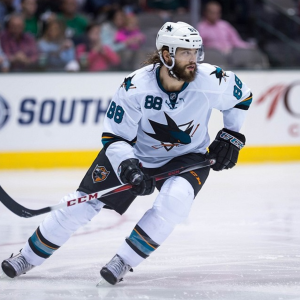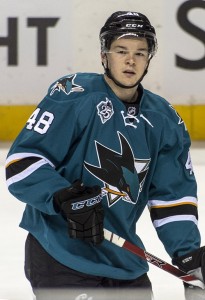A panic button is what you hit when you panic. You only hit it when the situation is dire and the odds are very much against you.
Let’s start by looking at facts, and closely related truisms, about the Sharks and Penguins series.
• History says teams down in a Stanley Cup Final by 2-0 have a 10% chance of winning the series.
• No team in the four rounds of the playoffs have managed to shut down Pittsburgh’s top three forward lines concurrently. That is, one might be shut down, maybe two, but never all three at the same time. This has held true for 20 games.
• San Jose has been close in both losses. Both games were tied with three minutes left.
• San Jose was only close because of superb goaltending, they have been outskated.
• Pittsburgh has not scored many goals, but they have dominated shots for the past two series. They have won the shot count in 11 consecutive games. Six times by double digits, three times by 20 or more.
• Pittsburgh has dominated puck possession this series.
• Pittsburgh has outscored San Jose 5-2 at even strength.
• Pittsburgh has 5 power plays to San Jose’s 3.
Does all this add up to a panic button? And what exactly is the Sharks panic button?
Hit it?
I’ll let readers decide whether this adds up to a ‘panic button moment’ — to me it’s a close call. The panic button move I described is moving Brent Burns to forward. The ‘Burns at forward’ history has been covered in detail. Suffice it to say that Burns has been excellent on defense since the calendar turned to 2016, including this series. He was also excellent as a forward, though his time there ended two seasons ago.

The question is not whether moving Burns to forward makes San Jose a better team in some generic sense. The question is matchup specific. Does this make San Jose a better team against Pittsburgh? I’m not trying to expand this into a permanent position change, or revive the forward versus defense argument. This is a specific change addressing a specific opponent and the specific matchup problems they have created for every opponent in the playoffs.
So many questions follow and here are a few.
Could Burns adjust quickly to the position? I’d argue yes, but there are ways to make the move which should work best.
How does San Jose address the blue line? The answer is complicated, though part of the answer is clear. The blue line will get worse. It could get a lot worse.
How would the Sharks forward lines look and would they effectively address the challenge the Penguins bring to the game? This is the silver chalice question and the answer is probably.
The Ripple Effects

There is no absolute answer on how quickly Burns would adjust. In his earlier move to forward, he was a first star in his second game at the position. It won’t take long, but there is not much time. Burns would be helped by being with familiar linemates. That would mean he goes on Joe Thornton’s line. It’d mean moving either Tomas Hertl or Joe Pavelski. I’d move Pavelski.
Hertl began his career on a line with Burns and Thornton and was very effective. Hertl might be the Sharks most effective forward in this series. They would form a very big, physical line. One of Burns major strengths, his forecheck, would create a challenge Pittsburgh hasn’t faced in the postseason.
If it is Pavelski that moves, he goes to another line and that line gets instantly better. A lot better. To fill out a second and third line, San Jose needs six forwards, five are givens. They are Pavelski, Logan Couture, Joel Ward, Patrick Marleau and Joonas Donskoi. The sixth spot is probably between Chris Tierney and Matt Nieto. My preference would be Dainius Zubrus, who is so savvy he fits with anyone, but Sharks coach Peter DeBoer isn’t going there.
I’d put Tierney in that sixth spot. Line 2 is the line that finished Game 2 – Ward, Couture and Donskoi. It was pretty effective in the third period. Line 3 is Pavelski, Marleau and Tierney. These lines can match up with any team in hockey, even Pittsburgh.
I would consider playing all three forward lines almost to the exclusion of a fourth line. Twenty minutes each. DeBoer spent the season rolling four lines to keep players fresher, now is the time he needs to concentrate time among his top players. Given how strong each line is, playing them equally is reasonable. I’ll come back to the fourth line after covering the defensive group and their dilemma.

Justin Braun and Marc-Edouard Vlasic are the top pair. They are getting 25+ minutes every game. Lefty Paul Martin is on the second pair and lefty Brenden Dillon on the third pair. These are four very competent defensemen.
Three right-handed defensemen are considered for two spots – Roman Polak, Dylan DeMelo and Matt Tennyson. I put all three into the lineup, and the two who play most effectively stay in the lineup. I would see if Roman Polak has better success with Paul Martin, and he well might. We already know Dillon and Polak do not have great chemistry, and I’m done with that pairing for this series.
DeMelo and Tennyson both showed chemistry with Dillon. I’d rotate DeMelo and Tennyson in with both Martin and Dillon. Whatever works best in the first period or first half of the game, I go with the rest of the way. No learning curve, just go play smart hockey and whatever combinations work best out of the box, they get the job.
Since I dress seven defensemen, my fourth forward line consists of just two players. I’d go with the two best penalty killers from among Nick Spaling, Dainius Zubrus, Matt Nieto, Melker Karlsson and Tommy Wingels. These are all good chocies. I’d go Zubrus (nearly an hour of PK time this season, no goals against, best in the league) and Nieto, though it is a close call. Nieto and Zubrus can fill in on other lines as needed to give players a breather.
http://gty.im/537482414
The Rollout
Here is what I’d roll out:
Forwards
Thornton, Burns, Hertl
Couture, Ward, Donskoi
Pavelski, Marleau, Tierney
Zubrus, Nieto
Defense
Vlasic-Braun
Polak-Martin
Dillon-DeMelo/Tennyson

DeBoer is not a panic button type, but trips to the Stanley Cup Final are few and far between. He can look at the third period from Game 2, where line adjustments coincided with a good 20 minutes, and decide he has found a meaningful adjustment. Couple those adjustments with home ice and last change, and maybe it is enough to change the series. The counterpoint is that San Jose had a very good second period in Game 1, and then Pittsburgh outshot the Sharks 18-9 in the third. One good period is not a trend. DeBoer needs a trend.
There are many ways DeBoer could execute moving Burns to forward, he could even do this within a game. He spent much of the season leaning on five defenseman, while sitting the sixth (Tennyson or DeMelo) in the third period. He could do the same against the Penguins. There are multiple ways to panic.
Moving Burns is a panic button move. Are the Sharks a better team doing this? Probably not in a generic sense, but this is not a generic situation. The right question: Are the Sharks a better matchup doing this against the Pittsburgh Penguins? Probably yes, as the Penguins are a unique challenge.
A lot could go wrong here, especially on defense, but a lot has already gone wrong in the series, and not nearly enough has gone right. Considering this is the fourth series in a row that things have gone badly for the Penguins’ opponents trying to match against their forwards, staying a similar course also carries plenty of risk.
Is it time to hit the panic button? Feel free to weigh in below with your plan of attack.